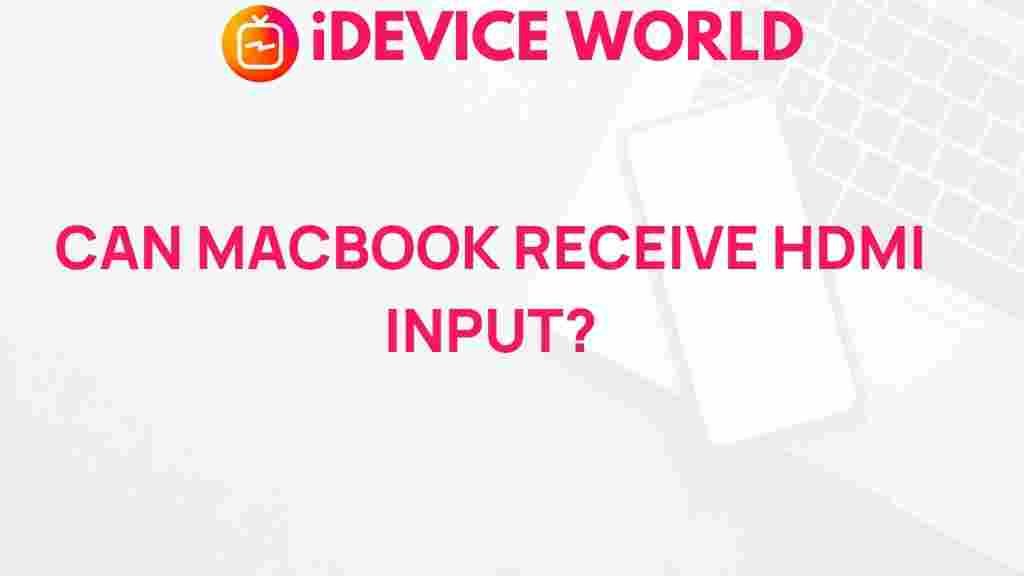MacBook: Unlocking the Mystery of HDMI Input
In the ever-evolving world of technology, one question that often arises among MacBook users is: Can my MacBook accept HDMI input? As Apple continues to innovate, understanding the capabilities of your devices becomes essential. This article delves deep into the HDMI functionality of MacBooks, clarifying their input capabilities, exploring alternative solutions, and offering troubleshooting tips for any related issues.
Understanding HDMI and MacBook Functionality
HDMI, or High-Definition Multimedia Interface, is a widely used standard for transmitting high-quality audio and video from one device to another. It’s commonly used for connecting televisions, projectors, and monitors. However, the specific functionality of HDMI ports can vary across different devices.
Can MacBook Accept HDMI Input?
To address the central question: No, MacBooks cannot accept HDMI input directly. While MacBooks are equipped with HDMI output ports that allow users to connect their laptops to external displays, these ports are not designed to receive input from other devices. The HDMI port on a MacBook is primarily used to output video and audio signals.
Exploring the HDMI Output Capabilities of MacBooks
MacBooks can seamlessly connect to a variety of external displays, enhancing your experience whether for presentations, gaming, or simply expanding your desktop workspace. Here’s how:
- External Monitors: Connect your MacBook to an external monitor to increase productivity or enjoy media on a larger screen.
- Projectors: Ideal for presentations, you can easily project your MacBook display onto a larger screen for group settings.
- TVs: Stream movies or shows directly from your MacBook to your television using an HDMI cable.
How to Connect Your MacBook to an External Display via HDMI
Connecting your MacBook to an external display using HDMI is a straightforward process. Follow these steps:
- Gather Your Equipment: Ensure you have an HDMI cable and an external display (monitor, projector, or TV).
- Locate the HDMI Port: Depending on the model, your MacBook may have an HDMI port or require an adapter (USB-C to HDMI).
- Connect the Cable: Plug one end of the HDMI cable into your MacBook and the other end into the HDMI input of the external display.
- Select the Correct Input: On your external display, switch to the HDMI input that corresponds to the port you are using.
- Configure Display Settings: On your MacBook, go to System Preferences > Displays. Here you can choose to mirror your display or use it as an extended desktop.
Once these steps are completed, your MacBook should display content on the external monitor, providing a larger workspace or an enhanced viewing experience.
Alternative Solutions for HDMI Input
Since MacBooks cannot accept HDMI input directly, users may wonder about alternatives for capturing video or using their MacBook for streaming purposes. Here are some methods:
- Using a Capture Card: If you’re looking to record or stream gameplay or other HDMI output from another device (like a gaming console), a capture card can facilitate this. These devices can take HDMI input and connect to your MacBook via USB.
- Screen Sharing Apps: For connecting devices over a network, consider using applications like Apple TV or AirPlay to stream content from your iPhone or iPad to your MacBook.
- External USB Devices: Some USB devices can allow your MacBook to receive video input, but they often come with limitations and may not support HDMI.
Troubleshooting HDMI Connection Issues
When connecting your MacBook to an external display, you may encounter various issues. Here are some troubleshooting tips to resolve common problems:
- No Signal on External Display: Ensure that the HDMI cable is securely connected on both ends. Check if the external device is set to the correct HDMI input.
- Flickering or Distorted Display: Try using a different HDMI cable or port. You may also need to adjust the display resolution on your MacBook.
- Audio Issues: If sound isn’t coming from the external device, go to System Preferences > Sound and select the correct output device.
Conclusion
In summary, while the MacBook is a powerful device capable of enhancing your productivity and entertainment through HDMI output, it does not support HDMI input directly. Understanding these capabilities allows you to make the most of your MacBook’s features. By using capture cards and screen sharing apps, you can still connect and interact with other devices in innovative ways.
For further exploration of your MacBook’s features and functionalities, consider checking out Apple’s official support page. Embrace the technology and unlock the potential of your MacBook!
This article is in the category Reviews and created by iDeciveWorld Team
